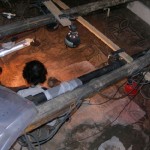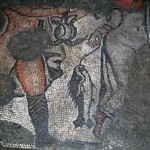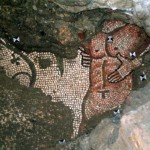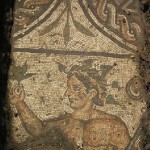 It’s not so unusual to find ancient remains under churches in Italian cities. Pretty much everything was built on top of a pre-existing Roman structure, and the Cathedral of Reggio Emilia is no exception.
It’s not so unusual to find ancient remains under churches in Italian cities. Pretty much everything was built on top of a pre-existing Roman structure, and the Cathedral of Reggio Emilia is no exception.
This particular mosaic is notable both in size and in subject matter.
The mosaic pavement, which measures 13 square meters (140 square feet) and dates to the fourth century A.D., was unearthed at a depth of about 4 meters (13 feet) below the the ground’s surface during archaeological investigations in the crypt of the Cathedral of Reggio Emilia, in central-northern Italy.
“The size and design of the mosaic pavement suggest that it formed the floor of a huge room. We believe this was the residence of a wealthy Roman,” Renata Curina, the archaeologist in charge of the dig, told Discovery News.
It’s also full of nekkid people. Nekkid guy holding a lotus flower, nekkid guy carrying a brace of ducks, nekkid chick carrying a fish.
Again, not unusual to find nudes in ancient mosaics but the symbols and motifs are unique, possibly suggesting the homeowner worshiped one of the many varietals of imported deities.
According to Luigi Malnati, superintendent of archaeological heritage in Emilia Romagna, such pagan scenes must have been pieced together before 380 A.D., the year when the emperor Theodosius proclaimed Christianity the state religion. Indeed, a series of decrees in 391-392 A.D. banned and punished pagan cult practices within the empire.
And now, because I’m nice like that, here are all the pictures of nekkid mosaic people I could find:



Even the fish is nekkid!
Great find. The detail and shading of the torso is wonderful.
Particularly for a 4th c. piece. The homeowner must have been one rich sumbitch.
Interesting find! Quick question from someone not too familiar with finds like this- how many of the Italian churches have been “explored” underneath their foundations? Just curious about how much could be found!
I would think very few have been excavated. Most churches have an active “basement” level used as a crypt for local luminaries, but lower than that they don’t go.
San Clemente in Rome is the only example I can think of which has been extensively excavated, and the results are spectacular.
If you could do some kind of imaging of the floors of many european churches – oh boy the things you’d find! Holy spots are holy spots and subsequent religions usually adopt the holy spots of their predecessors.
Oh yes indeed. There’s a great church in Rome called San Clemente where you can see all 3 layers: the current 12th c. basilica, the earlier 4th c. basilica, and the 1st c. Roman structure underneath which includes a Mithraeum.
The City Museum in Barcelona has an underground excavation into the old Roman city, through which you can wander away as far as the rock foundations of La Seu, the cathedral. It’s one of the best museum experiences I’ve had — maybe the best. (But I’ve never been to any of the Really Big Museums — British, Louvre, or the city of Rome…)
I remember you telling me about the City Museum. Rome has begun exploring the possibilities of underground excavations of buildings in current use lately.
Much of what has been excavated is the famous outdoors stuff, but underground the old cities just sit there unexplored, holding up newer structures. It’s the next new archaeological frontier: what’s underneath everything.
wtf this is not interesting at all. my dont care about this fing stuff my need to know more stuff than wat u put for i. not important.
jk lol i bet i had you readers going. sorry if i pissed you off but i just had a lot of candy and i needed to make fun of something lol. and ps i dont care wat u do to me for this cause this isnt my email!!!
I doubt my readers think I’m so delicate that I need to be protected from the big scary AOLer. Besides, what exactly could I do to you even if it were your email?
btw its naked not nekked then your just saying n-ee-k-ed
It’s a phonetic spelling, son.